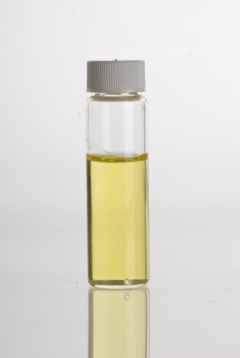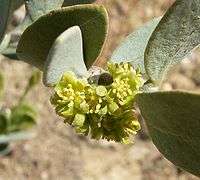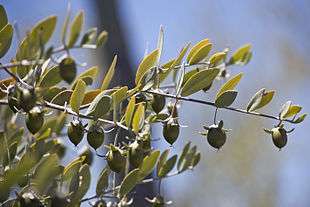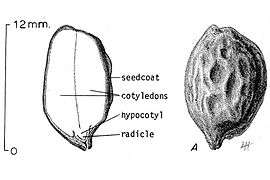Jojoba oil
Jojoba oil /həˈhoʊbə/ (![]()

History
The O'odham Native American tribe extracted the oil from jojoba seeds to treat sores and wounds. The collection and processing of the seed from naturally occurring stands marked the beginning of jojoba domestication in the early 1970s.[3]
In 1943, natural resources of the U.S, including jojoba oil, were used during war as additives to motor oil, transmission oil and differential gear oil. Machine guns were lubricated and maintained with jojoba.[4]
Appearance
Unrefined jojoba oil appears as a clear golden liquid at room temperature with a slightly nutty odor. Refined jojoba oil is colorless and odorless. The melting point of jojoba oil is approximately 10 °C[5] and the iodine value is approximately 80.[6] Jojoba oil is relatively shelf-stable when compared with other vegetable oils mainly because it contains few triglycerides, unlike most other vegetable oils such as grape seed oil and coconut oil.[7] It has an oxidative stability index of approximately 60,[8] which means that it is more shelf-stable than safflower oil, canola oil, almond oil or squalene but less than castor oil and coconut oil.
Chemistry
| freezing point | 7-10.6 °C[9][10] |
| refractive index | 1.4650 at 25 °C[9] |
| specific gravity | 0.863 at 25 °C[9] |
| smoke point | 195 °C[10] |
| flash point | 295 °C[9] |
| iodine number | 82[9] |
| viscosity | 48 SUS at 99 °C[10]
127 SUS at 37.8 °C[10] |
| viscosity index | 190-230[11] |
Fatty acids present in jojoba oil[12]
| Fatty acid | Carbon atoms:double bonds | double bond positions | Percentage (mole fraction) |
| Palmitic acid | C16:0 | - | 0.3 |
| Palmitoleic acid | C16:1 | 9 | 0.3 |
| Stearic acid | C18:0 | - | 0.2 |
| Oleic acid | C18:1 | 9 | 9.3 |
| Arachidic acid | C20:0 | - | - |
| 11-Eicosenoic acid | C20:1 | 11 | 76.7 |
| Behenic acid | C22:0 | - | trace |
| Erucic acid | C22:1 | 13 | 12.1 |
| Lignoceric acid | C24:0 | - | 0.1 |
| Nervonic acid | C24:1 | 15 | 1.0 |
The fatty acid content of Jojoba oil can vary significantly depending on the soil and climate in which the plant is grown, as well as when it is harvested and how the oil is processed. In general, it contains a high proportion of mono-unsaturated fatty acids, primarily 11-Eicosenoic acid (Gondoic acid).
Uses
Being derived from a plant that is slow-growing and difficult to cultivate, jojoba oil is mainly used for small-scale applications such as pharmaceuticals and cosmetics.[13] Overall, it is used as a replacement for whale oil and its derivatives, such as cetyl alcohol. The ban on importing whale oil to the U.S. in 1971 led to the discovery that jojoba oil is "in many regards superior to sperm whale oil for applications in the cosmetics and other industries".[2]
Jojoba oil is found as an additive in many cosmetic products, especially those marketed as being made from natural ingredients. In particular, such products commonly containing jojoba are lotions and moisturizers, hair shampoos and conditioners. The pure oil itself may also be used on skin, hair, or cuticles.[14][15]
Like olestra, jojoba oil is edible but non-caloric and non-digestible, meaning the oil will pass out of the intestines unchanged and can mimic steatorrhea—a health condition characterized by the inability to digest or absorb normal dietary fats. Thus, this indigestible oil is present in the stool but does not indicate an intestinal disease. If consumption of jojoba oil is discontinued in a healthy person, the indigestible oil in the stool will disappear. Jojoba oil also contains approximately 12.1% of the fatty acid erucic acid that would appear to have toxic effects on the heart at high enough doses, if it were digestible.[16]
Although impractical, jojoba biodiesel has been explored as a sustainable fuel that can serve as a substitute for petroleum diesel.[17]
Photo gallery
.jpg) Plant
Plant- Female flower
 Male flower
Male flower Fruits
Fruits Seed
Seed
References
- Sturtevant D, Lu S, Zhou ZW, Shen Y, Wang S, Song JM, et al. (March 2020). "Simmondsia chinensis): A taxonomically isolated species that directs wax ester accumulation in its seeds". Science Advances. 6 (11): eaay3240. doi:10.1126/sciadv.aay3240. PMC 7065883. PMID 32195345.
- Undersander DJ, Oelke EA, Kaminski AR, Doll JD, Putnam DH, Combs SM, Hanson CV (1990). Jojoba. Alternative field crops manual (Report). University of Wisconsin-Exension, Cooperative Extension.
- "Jojoba". hort.purdue.edu. Retrieved 2016-04-17.
- Gentry HS (1958-01-01). "The Natural History of Jojoba (Simmondsia chinensis) and Its Cultural Aspects". Economic Botany. 12 (3): 261–295. doi:10.1007/bf02859772. JSTOR 4287990.
- "AOCS Method Cc 18-80". The American Oil Chemists' Society (AOCS). Archived from the original on 2007-03-13. Retrieved 2006-10-13.
- "AOCS Method Cd 1-25". The American Oil Chemists' Society (AOCS). Archived from the original on 2007-03-13. Retrieved 2006-10-13.
- "Learn the powerful benefits of jojoba oil". TheJojobaOil.com. Retrieved 1 July 2011.
- "AOCS Method Cd 12b-92". The American Oil Chemists' Society (AOCS). Archived from the original on 2007-03-13. Retrieved 2006-10-13.
- Wisniak J (1987). The chemistry and technology of jojoba oil. The American Oil Chemists Society. p. 24. ISBN 978-0-935315-17-2.
- El Bassam N (1998). Energy Plant Species: Their Use and Impact on Environment and Development. p. 168. ISBN 978-1-873936-75-7.
- Heilweil IJ. Review of Lubricant Properties of Jojoba Oil and its Derivatives. ISBN 978-0-935315-22-6.
- Busson-Breysse J, Farines M, Soulier J (1994). "Jojoba wax: Its esters and some of its minor components". Journal of the American Oil Chemists' Society. 71 (9): 999–1002. doi:10.1007/BF02542268. ISSN 0003-021X. S2CID 85377122.
- Wolfmeier U, Schmidt H, Heinrichs FL, Michalczyk G, Payer W, Dietsche W, Boehlke K, Hohner G, Wildgruber J (2002). "Waxes". Ullmann's Encyclopedia of Industrial Chemistry. Weinheim: Wiley-VCH. doi:10.1002/14356007.a28_103. ISBN 3527306730..
- "Jojoba Oil for Nails: Natural Care for Your Perfect Manicure". Body (personal) care. Oily Oily. Retrieved 29 August 2013.
- Lynn M (20 March 2011). "Jojoba Oil Benefits". Livestrong. Retrieved 29 August 2013.
- Place AR (September 1992). "Comparative aspects of lipid digestion and absorption: physiological correlates of wax ester digestion" (abstract). The American Journal of Physiology. 263 (3 Pt 2): R464-71. doi:10.1152/ajpregu.1992.263.3.R464. PMID 1415629.
- Sample I (March 6, 2003). "Jojoba oil could fuel cars and trucks". New Scientist. Retrieved 2006-10-13.
External links
- International Jojoba Export Council
- Naqvi, H.H.; I.P. Ting (1990). "Jojoba: A unique liquid wax producer from the American desert". Advances in new crops. Timber Press, Portland, OR. pp. 247–251.
- Description and chemical structure of jojoba oil
- Can This Unassuming Little Desert Shrub Really Save The World? - The first article from 1977